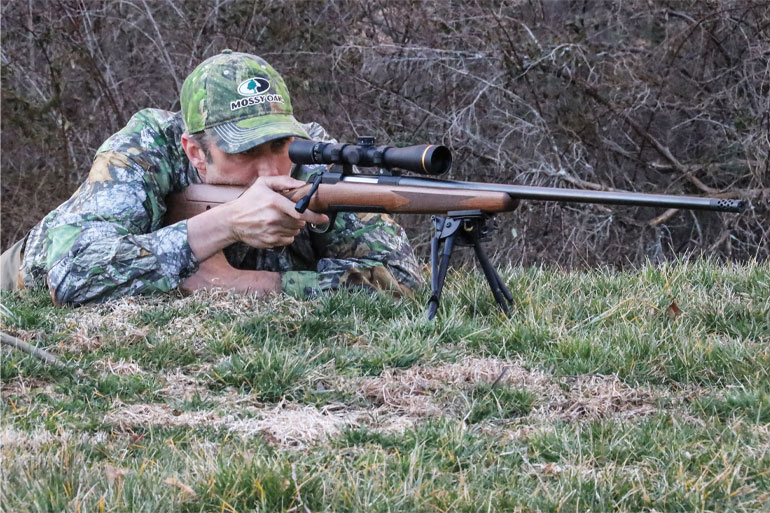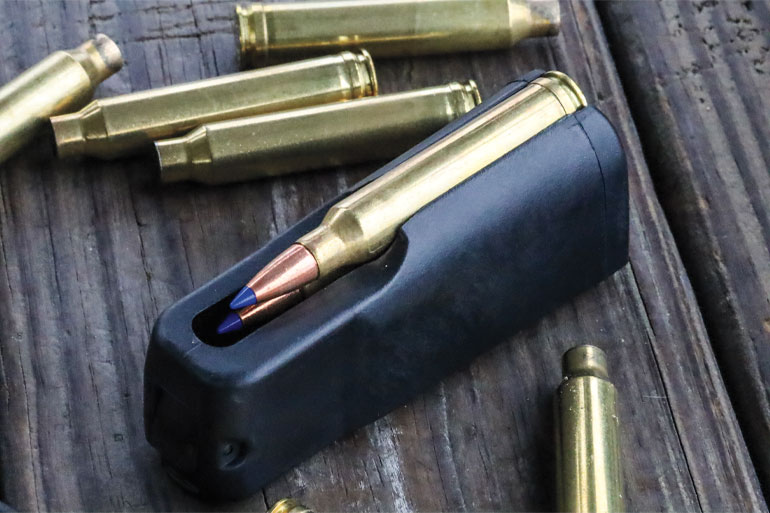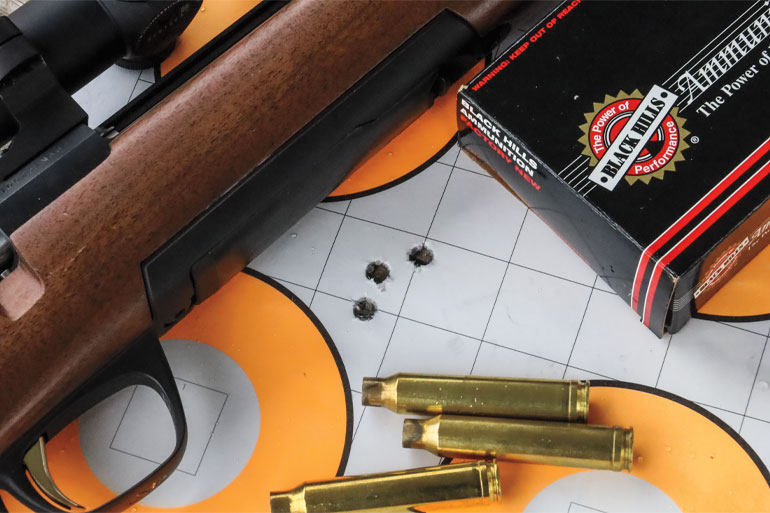
The hottest trend in the hunting market is bolt-action rifles that incorporate elements traditionally found on long-range competition and tactical rifles into field guns. Perhaps no other firearms manufacturer has been as quick to jump on this trend as Browning, and scrolling through its current lineup of X-Bolt rifles is a tutorial in how to build a crossover gun.
This year, Browning has added yet another hybrid hunting rifle to its catalog: the X-Bolt Hunter Long Range. The first feature you’ll notice on the Hunter Long Range is its walnut stock. This may come as a bit of a shock in an age where polymer parts have replaced steel and wood, but there’s definitely renewed interest in walnut-stocked guns.

The X-Bolt Hunter Long Range borrows a design element Browning uses on its competition shotguns: a height-adjustable cheekpiece that provides perfect eye alignment regardless of shooting angle or face shape.
The comb itself angles upward, giving the gun a Monte Carlo silhouette in profile. Riding on two metal posts, the comb can be raised over two inches, which is more range than almost any shooter will require. A heavy-duty hex-head nut holds the comb in position, and the nut is accessed through the right side of the stock. It might not be as convenient as, say, the Savage 110 Classic’s push-button design, but the Browning lacks the large, round metal buttons that you’ll find on the Savage stock.
X-Bolt Hunter Long Range rifles feature a satin-finished Grade I walnut stock, and while the wood isn’t particularly fancy, it’s far better than some competing entry-level rifles that look as though they were stocked using the leftovers from your high school woodshop class. The Browning’s stock has traditional diamond checkering on the fore-end and pistol grip, and the Hunter Long Range lacks the 45-degree angled cut that has become a hallmark of other X-Bolt rifles in favor of a more traditional look.
The stock is also outfitted with Browning’s Inflex Technology recoil pad, which has an internal skeleton that directs recoil down and away from the shooter’s face.
The Hunter Long Range shares much of its design architecture with other Browning X-Bolt rifles, and that’s a good thing. All X-Bolt rifles use a three-lug push-feed bolt with a plunger-type extractor. The bolt design allows for a short bolt lift and fast cycling, and there’s a ring of steel that surrounds the case head to offer added strength. The rear of the bolt shroud is enclosed, and a small, red cocking indicator protrudes beneath the shroud.
The real genius of the X-Bolt rifles—and what makes them so accurate out of the box—is the barrel design and the way in which the barreled action is mated to the stock. All X-Bolt barrels are button-rifled, air gauged and hand chambered, and they all benefit from Browning’s proprietary lapping process.
Headspacing is tightly controlled, and the receiver is mated to the stock with epoxy bedding at the front and rear of the action. That ensures a perfect action-to-stock fit and improved consistency from shot to shot. The barrel is free-floated, but Browning doesn’t leave a gaping channel between the barrel and stock like some competing firearm manufacturers.
Like other X-Bolt rifles, the Hunter Long Range comes with a tang-mounted two-position safety and a bolt-unlock button located at the top of the bolt handle. The bolt unlock allows the action to be cycled with the safety engaged. The system is not only safe but also functional, as it prevents the bolt from accidentally falling open while walking through heavy cover. The tang safety is another practical feature for hunters because it allows you to quickly and quietly release the safety with minimal movement.

The Hunter Long Range comes with an oversize bolt handle with flat cuts on the sides of the bolt knob for added control and easier cycling.
Browning’s Feather Trigger is one of the best production triggers on the market. Its three-lever design allows for ample sear engagement with a light, crisp break. The trigger in the Hunter Long Range I tested broke at an average of 3.3 pounds, and there was virtually no creep or take-up.
I am a fan not only of the trigger’s internal design and feel but also of its ergonomics. The relatively flat trigger face offers complete control when firing for improved consistency and smaller groups. And, in signature Browning fashion, the trigger is gold-plated.
Browning’s rotary magazine is among the best you’ll find in any production rifle. It fits neatly inside the stock and locks securely in place, and it falls into the hand when the release, which is located at the front of the mag, is depressed. The rotary design makes it easy to load, and I’ve never had any functioning issues with these mags.

Cartridges feed smoothly into the chamber when the bolt is pressed forward, and there’s none of the ratcheting effect you’ll encounter when trying to chamber a round in other bolt guns. The Browning is a smooth-cycling bolt rifle that runs flawlessly.
All Hunter Long Range rifles are outfitted with heavy sporter barrels regardless of caliber, but barrel length depends upon which of the seven available chamber offerings you choose. The 6.5 Creedmoor, .308, .270 Win. and .30-06 guns all come with 22-inch barrels, the 6.5 PRC gets a 24-inch barrel, and both magnum versions come with 26-inch pipes.
The barrel and action both feature a matte black finish on the metal that reduces glare and looks very good with the satin stock finish. Hunter Long Range rifles come with 5/8×24 threaded muzzles and include both a muzzle brake and a thread protector.
Unlike some of the current hunting/target crossover guns, the Browning guns are light enough to actually carry in the field. Weights range from about seven pounds, 11 ounces to eight pounds, six ounces, with some variance for wood density.
The .300 Win. Mag. I tested weighed seven pounds, 13 ounces on my digital scale, which was within an ounce of the advertised weight and light enough to carry on all but the most strenuous hunts. Length of pull was 13.66 inches, and the gun’s overall length was 46.75 inches. Suggested retail prices for these rifles range from about $1,300 to $1,330 depending on caliber.
Browning gave the Hunter Long Range .300 Win. Mag. a 1:8 twist, which proves that Browning understands what its customers want and need. The trend in both hunting and competition/target shooting is toward heavy-for-caliber, high-ballistic-coefficient bullets, and the Hunter Long Range’s fast twist rate means it will effectively stabilize the 200-grain and heavier projectiles that are in favor among .30 caliber long-range shooters.
Two of the three test loads I used—Black Hills’ boattail hollowpoint and Barnes’ LRX boattail—weighed 190 grains, the heaviest .300 Win. Mag. factory loads I had on hand. I also tested the rifle with Hornady’s 165-grain Superformance GMX round to see how the rifle performed with lighter hunting bullets.

Accuracy was consistent across the board, as you can see in the accompanying chart. The best single group came with the Hornady load, and it was right around an inch.
For a factory rifle shooting factory ammo that’s good, and if you worked to find a factory load that the gun really liked I believe that, like most of the other X-Bolts I’ve shot, you could get the gun in the 0.75-inch range or better. It’s good to know the first three loads I tested went around an inch or even lower, and that bodes well for how these guns will perform in the field and on the range.
Like other X-Bolt rifles, the Hunter LR has superb ergonomics. The grip has a shallower angle than some dedicated target rifles—including other guns in the X-Bolt line—but the Hunter Long Range is comfortable to shoot from prone and standing positions and from a bench.
The right-hand palm swell is a nice feature, and as previously mentioned, the control layout is the most logical of any hunting rifle out there. Those who haven’t grown accustomed to the bolt release button may not like the setup initially, but it soon becomes second nature to unlock the action with the gun on Safe. The tang safety has a low profile, so it won’t hang up or disengage when the shooter grabs hold of the pistol grip, which are issues I’ve had with other rifles that wore tang safeties.
The gun functioned flawlessly throughout testing, and the ejection port is wide enough that single loading is not an issue. Like most X-Bolts, the Hunter Long Range uses X-Lock bases that secure bases to the receiver with four screws in each base instead of two. I used Leupold bases, and to Leupold’s credit, the company gives step-by-step installation instructions, including how many inch-pounds each screw should be tightened and in which order. Follow those directions and you won’t have a problem.
I topped the rifle with Leupold’s new 30mm VX-3i 4.5-14×40 CDS-ZL scope, and the rifle and optics weighed in at around 10 pounds loaded—not exactly mountain-rifle light but perfect for a dual-purpose target/hunting rifle. The Hunter Long Range isn’t so heavy or cumbersome it can’t be carried while hunting, and yet the added weight and the muzzle brake and Inflex pad take the sting out of recoil when shooting lots of targets from a stationary position.
I find that higher combs allow me to shoot shotguns and rifles more comfortably, and having the ability to quickly adjust the comb height is a benefit for me. It’s also a benefit for those shooters who prefer optics with large objective lenses and tall rings and find themselves breaking their cheek weld to see through optics that are mounted high above the bore.
What’s more, if you prefer a more traditional-looking gun, you can lower the Hunter Long Range’s comb and swap out the muzzle brake for the thread protector and transform your target rifle into a sporter.
Despite entering the 13th year of production, the X-Bolt family of rifles still feels fresh and current. That’s due, at least in part, to guns like the Hunter Long Range. It offers many of the advantages of a target rifle without looking as though you’ve just dragged it to the woods directly from a PRS match. It effectively plays the middle ground between a tactical rifle and a hunting gun, offering the benefits of the former without losing the soul of the latter. Whether you’re chasing elk or ringing steel, this gun has you covered.
Browning X-Bolt Hunter Long Range Specs
- Type: Bolt-action centerfire
- Caliber: 6.5 Creedmoor, 6.5 PRC, .270 Win., 7mm Rem. Mag., .308 Win., .30-06, .300 Win. Mag. (tested)
- Capacity: 3+1
- Barrel: 26 in. (as tested), heavy sporter contour, threaded 5/8×24, muzzle brake, thread protector
- Overall Length: 46.75 in.
- Weight: 7 lb., 13 oz.
- Stock: Grade 1 satin-finished black walnut finish matte blue
- Trigger: Feather adjustable; 3.3 lb. pull (measured, as received)
- Sights: None; drilled and tapped
- Price: $1,330
- Manufacturer: Browning, browning.com
Browning X-Bolt Hunter Long Range Accuracy Results



